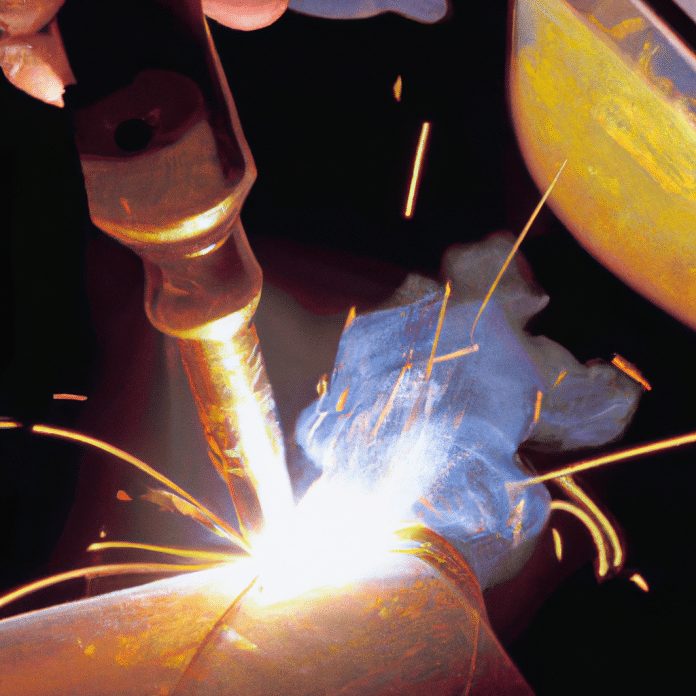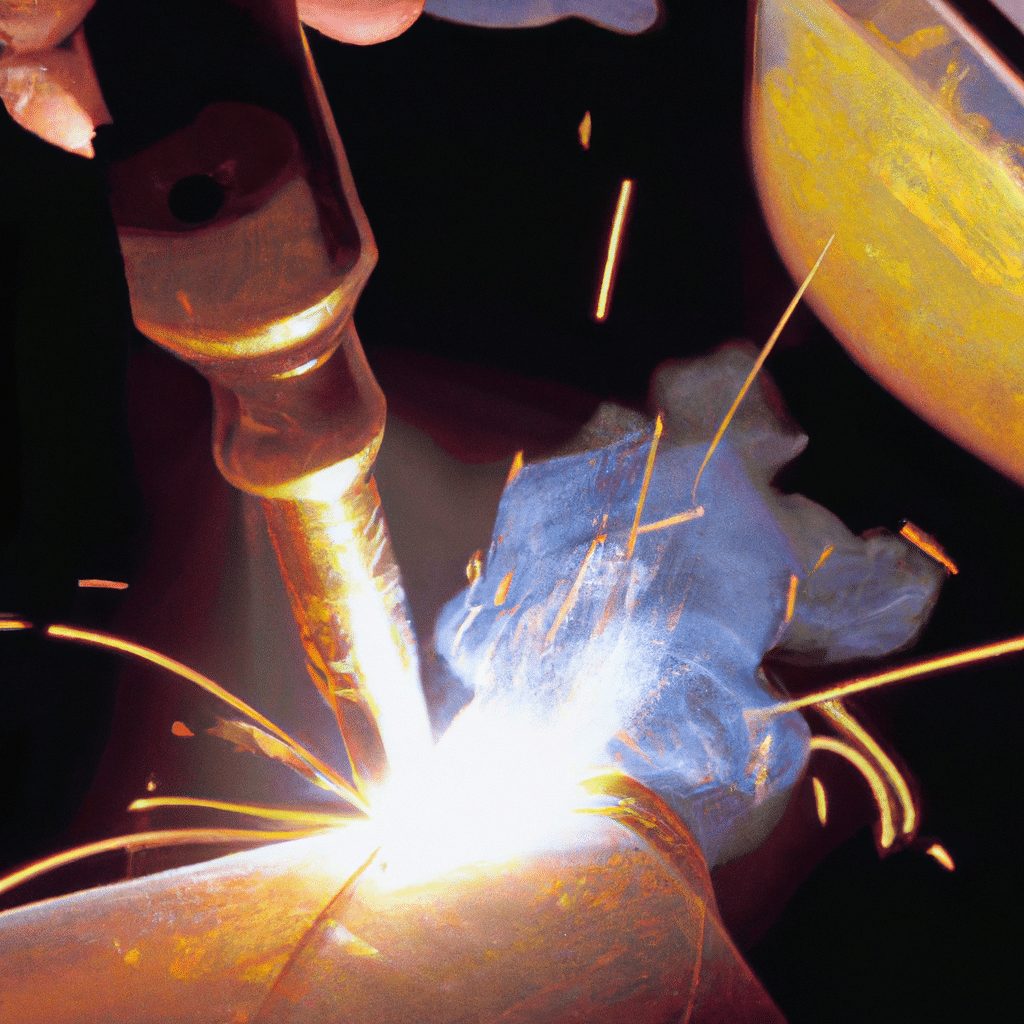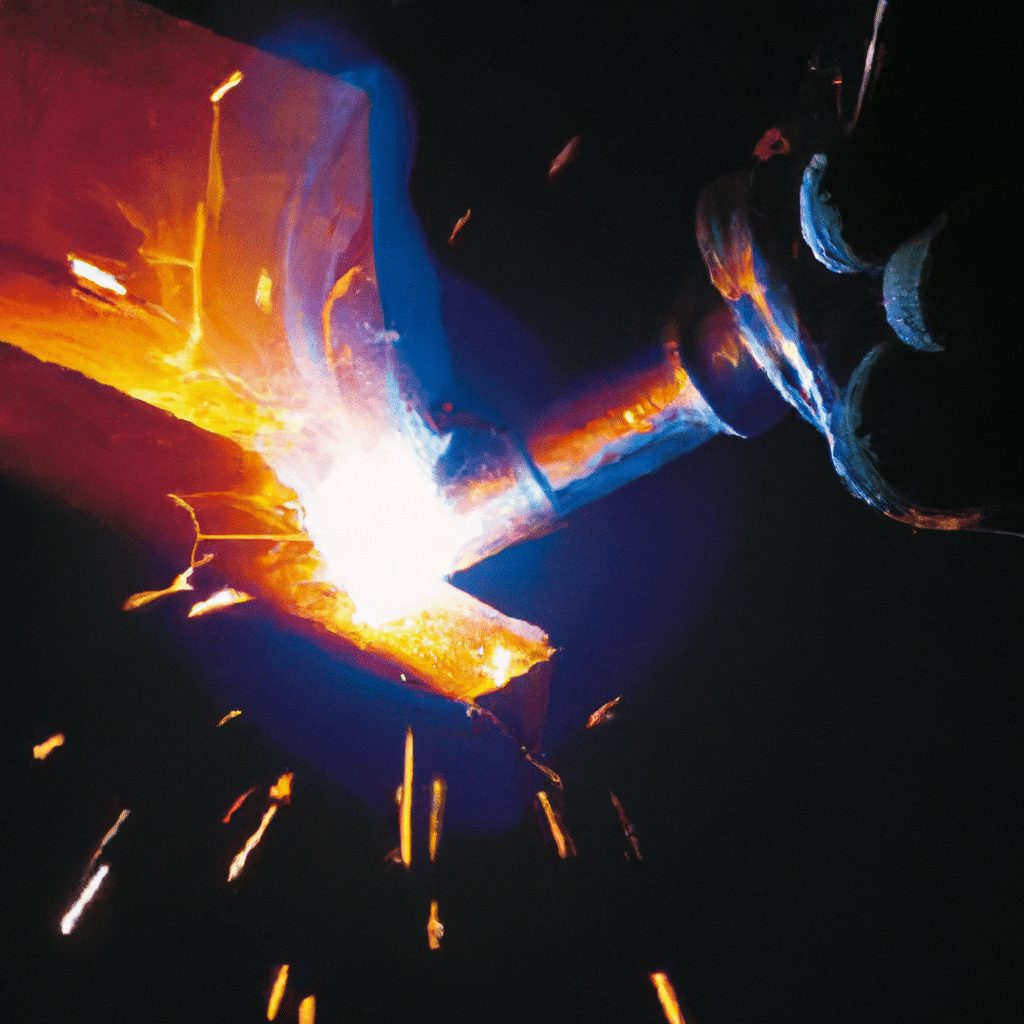Wondering if you can weld with a TIG torch? Well, we’re here to tell you that yes, you absolutely can! TIG welding, also known as Gas Tungsten Arc Welding, is a versatile and precise welding method that allows for clean and accurate welds on a variety of materials. Whether you’re a seasoned welder or just starting out, TIG welding with a TIG torch opens up a world of possibilities for creating strong and beautiful welds. So, let’s dive into the world of TIG welding and explore all the amazing things you can accomplish with this incredible tool!
Review contents
What is a TIG Torch?
Definition of TIG Torch
A TIG torch, also known as a GTAW torch (Gas Tungsten Arc Welding torch), is a tool used in the welding process. It is specifically designed for Tungsten Inert Gas (TIG) welding, which is a high-quality welding technique that uses a non-consumable tungsten electrode to create an electric arc and join metal pieces together. The TIG torch plays a crucial role in this process by supplying the necessary heat and controlling the welding arc.
Components of a TIG Torch
A TIG torch consists of several essential components that work together to ensure a smooth and efficient welding operation. These components include:
- Handle: The handle provides a comfortable grip for the welder and is usually made of heat-resistant materials.
- Torch Head: The torch head houses various parts such as the collet, collet body, and nozzle.
- Collet: The collet holds the tungsten electrode securely in place.
- Collet Body: The collet body connects the collet to the torch head and allows for adjustments in electrode stick-out length.
- Nozzle: The nozzle directs the flow of shielding gas and helps protect the weld zone from external contaminants.
- Tungsten Electrode: The tungsten electrode serves as the conductor that creates the electrical arc and generates the heat required for welding.
- Gas Cup: The gas cup surrounds the welding area and ensures proper shielding gas coverage.
- Cable: The cable connects the TIG torch to the power source, supplying the necessary electrical current for welding.
How Does a TIG Torch Work?
Controlling the Welding Arc
A TIG torch operates by controlling the welding arc between the non-consumable tungsten electrode and the workpiece. The welder initiates the arc by pressing the torch’s trigger, allowing current to flow through the electrode and generate a high-temperature plasma arc. The arc provides the heat needed to melt the base metal and any filler metal, resulting in a strong bond between the two.
Gas Flow and Shielding
One crucial aspect of TIG welding is the use of shielding gas to protect the molten weld zone from atmospheric contamination. The TIG torch directs a flow of inert gas, typically argon, onto the weld pool and the electrode. This gas displaces any surrounding air and forms a protective shield that prevents oxidation and other detrimental reactions during the welding process.
Tungsten Electrode and Filler Rods
The TIG torch relies on a non-consumable tungsten electrode to create the electric arc. Tungsten is selected for its high melting point, durability, and ability to carry high current densities without easily vaporizing. It remains a constant component of the torch, unlike consumable electrodes used in other welding processes.
In some cases, TIG welding requires the use of filler rods to reinforce the weld joint or achieve the desired metal composition. The filler rod, made of the same or compatible material as the base metal, is manually fed into the weld pool as needed.
Power Source and Controls
A TIG torch connects to a power source, such as a welding machine or an electrical outlet, to provide the necessary current for welding. These power sources often have various controls to adjust the welding parameters, including current intensity, pulse settings, and gas flow. The welder operates these controls to achieve the desired weld characteristics, such as penetration depth, bead appearance, and overall quality.
Advantages of Using a TIG Torch for Welding
Precision and Control
One of the primary advantages of using a TIG torch for welding is its exceptional precision and control. The TIG welding process allows welders to create intricate and accurate welds, making it ideal for applications that require utmost precision, such as small and delicate parts or high-quality fabrications.
Clean and High-Quality Welds
TIG welding produces clean and high-quality welds due to its precise control over the welding parameters. The ability to control the arc, heat input, and filler rod contribution allows for clean weld beads, minimal distortion, and excellent weld penetration. This makes it suitable for critical applications, where weld integrity is crucial.
Versatility in Materials
TIG welding is highly versatile and can be used to weld a wide range of materials, including stainless steel, carbon steel, aluminum, copper, titanium, and even exotic metals. The process’s ability to provide precise control over heat input and arc characteristics makes it adaptable to various metal types and thicknesses.
Suitability for Thin Metals
When welding thin metals, it is crucial to avoid excessive heat input and minimize distortion. TIG welding excels in this aspect, as it allows for precise heat control and uses a smaller electrode compared to other welding processes. The low heat input and minimal distortion make TIG welding suitable for thin materials, such as sheet metal or thin-walled tubing.
Can You Weld with a TIG Torch?
Yes, You Can
Absolutely! TIG welding with a TIG torch is a widely used welding technique that offers numerous advantages over other processes. Whether you are a professional welder or a DIY enthusiast, TIG welding with a TIG torch can provide you with the ability to create high-quality welds and work on various materials and applications.
Type of Welding Process
TIG welding falls under the category of arc welding, specifically gas tungsten arc welding (GTAW). This process utilizes a non-consumable tungsten electrode, therefore differentiating it from processes that use consumable electrodes, such as MIG (Metal Inert Gas) welding or Stick welding.
TIG Torch Setup
To weld with a TIG torch, you need to properly set up the torch and ensure all components are in good working condition. This includes selecting the appropriate tungsten electrode size and type, setting the gas flow rate and polarity, and attaching the necessary filler rod if needed. Following the manufacturer’s instructions and taking necessary safety precautions is vital for a successful TIG torch setup.
Safety Considerations
As with any welding process, safety is of utmost importance when using a TIG torch. It is essential to wear appropriate protective gear, including welding gloves, a welding helmet with a suitable shade, and fire-resistant clothing. Adequate ventilation and working in a well-ventilated area are also crucial to minimize exposure to hazardous fumes and gases. Additionally, proper grounding of the workpiece and safe handling of gas cylinders should be practiced to ensure a safe working environment.
Applications for TIG Welding with a TIG Torch
Automotive Industry
TIG welding is extensively used in the automotive industry for various applications, such as welding exhaust systems, chassis, and suspension components. The precision and control offered by TIG welding make it ideal for creating high-quality welds that meet the stringent requirements of automotive manufacturers.
Aerospace and Aviation
TIG welding plays a critical role in the aerospace and aviation sectors, where weld integrity and quality are essential for ensuring safety and reliability. It is commonly used for welding aircraft components, such as fuselage structures, engine parts, and fuel system components. The ability to weld aluminum and other lightweight materials with precision makes TIG welding a preferred choice in these industries.
Precision Fabrication
TIG welding is highly valued in precision fabrication, where intricate and accurate welds are necessary for manufacturing complex parts and components. It is commonly used in industries such as electronics, medical equipment, and jewelry making, where small, delicate welds are required.
Artistic Welding
TIG welding offers immense creative possibilities for artistic welding projects. The precise control over the welding arc and heat input allows artists and fabricators to create intricate metal sculptures, decorative pieces, and custom designs. The clean and aesthetically pleasing welds achieved through TIG welding make it a popular choice among artistic welders.
Pipe Welding and Plumbing
TIG welding is widely used for pipe welding and plumbing applications, particularly in industries such as construction, oil and gas, and petrochemicals. It enables welders to create strong and leak-free joints in various pipe materials, including stainless steel and copper, ensuring reliable fluid flow and structural integrity.
Required Equipment for TIG Welding with a TIG Torch
TIG Torch and Tungsten Electrode
The core equipment for TIG welding with a TIG torch includes the torch itself and the tungsten electrode. It is crucial to select the appropriate torch for your welding needs, considering factors such as torch amperage rating, length, and cooling method. The type and size of the tungsten electrode will depend on the material being welded and the desired welding characteristics.
Gas Regulator and Flowmeter
A gas regulator and flowmeter are essential components for regulating the flow of shielding gas from the gas cylinder to the TIG torch. These devices ensure that the proper flow rate of shielding gas is maintained, providing adequate protection for the weld zone.
Argon Gas Cylinder
Argon gas is the most commonly used shielding gas in TIG welding. It is inert and provides excellent protection against oxidation and other atmospheric contamination during the welding process. An appropriate-sized argon gas cylinder is necessary to supply sufficient shielding gas for your welding needs.
Welding Gloves and Safety Gear
Welding gloves are essential for protecting your hands from heat, sparks, and potential burns. Along with gloves, it is crucial to wear other appropriate safety gear, including a welding helmet with a suitable shade, safety glasses, and fire-resistant clothing. Proper safety gear ensures your personal safety while working with a TIG torch.
Metal Preparation Tools
Metal preparation tools, such as grinding wheels, wire brushes, and deburring tools, are necessary for cleaning and preparing the metal surfaces before welding. Removing any contaminants, oxides, or debris from the surfaces ensures proper weld penetration and adhesion.
Power Source and Grounding Clamp
A suitable power source, such as a TIG welding machine, is required to provide the necessary electrical current for TIG welding. Additionally, a grounding clamp is essential to establish a secure electrical connection and ensure safe and reliable welding operations.
Filler Rods
In certain welding applications, filler rods are required to reinforce the welds or achieve specific metal compositions. The selection and availability of filler rods will depend on the base metal being welded and the desired weld characteristics.
Techniques and Tips for TIG Welding with a TIG Torch
Proper Tungsten Preparation
Proper preparation of the tungsten electrode is crucial for successful TIG welding. It is essential to shape the electrode correctly, ensuring a pointed tip with a smooth and consistent finish. The tungsten electrode should be ground or sharpened perpendicular to its length and without contamination from other metals.
Setting up the TIG Torch
Proper setup of the TIG torch includes selecting the appropriate tungsten electrode size and type, setting the correct gas flow rate, and adjusting the amperage on the power source. Checking all connections and ensuring proper grounding is also essential for a successful welding operation.
Establishing the Weld Pool
To establish a molten weld pool, the TIG torch should be held at the correct angle, allowing the electrode to come into contact with the workpiece. It is important to maintain a steady hand and move the torch along the joint at a consistent speed. Proper manipulation of the torch and control over the heat input will ensure a stable and well-formed weld pool.
Controlling the Welding Arc
Maintaining control over the welding arc is essential for achieving high-quality welds. The welder should maintain a consistent arc length, typically between 1/8 to 1/4 inch, to ensure adequate heat input and prevent arc instability. Adjusting the amperage and controlling the torch movement and angle will help in effectively controlling the welding arc.
Adding Filler Rods
When using filler rods, it is important to feed the rod into the weld pool at the appropriate rate and angle. The welder should have a steady hand and ensure the filler rod melts evenly into the weld pool, creating a strong and consistent bond with the base metal.
Avoiding Contamination
Contamination of the tungsten electrode or the weld zone can significantly affect weld quality. It is important to avoid touching the tungsten electrode with the filler rod or other metal objects, as this can lead to contamination. Proper cleaning of the workpiece and ensuring minimal exposure to air and moisture will also help prevent contamination.
Tack Welding and Final Pass
For complex welding projects, tack welding can help ensure proper alignment and fit-up before executing the final weld. Tack welding involves creating small temporary welds to hold the pieces together. Once the alignment is correct, the final pass can be made to complete the weld. Taking time to plan and execute tack welding and the final pass with precision will result in a strong and visually appealing weld.
Common Mistakes to Avoid when TIG Welding with a TIG Torch
Insufficient Tungsten Extension
Tungsten extension refers to the distance between the tungsten electrode and the shielding gas nozzle. Insufficient tungsten extension can cause the electrode to overheat and fail prematurely. It is essential to ensure the correct extension length to maintain electrode durability and prevent weld defects.
Improper Shielding Gas Flow
Inadequate or excessive shielding gas flow can affect the quality of the weld and lead to porosity or contamination. It is important to set the gas flow rate according to the manufacturer’s recommendations and make adjustments as needed based on the welding conditions, material thickness, and joint configuration.
Inconsistent Arc Length
Maintaining a consistent arc length is critical for achieving quality welds. An inconsistent arc length can lead to irregular heat distribution, fusion issues, and poor penetration. It is important to practice maintaining a consistent arc length and adjust the torch position as necessary during the welding process.
Incorrect Ampere Settings
Using incorrect amperage settings can result in various weld defects, such as incomplete fusion, poor penetration, or overheating. It is crucial to select the appropriate amperage based on the material thickness, joint configuration, and welding position. Regularly monitoring and adjusting the amperage throughout the welding process will help achieve optimal weld results.
Contamination of Tungsten Electrode
Contamination of the tungsten electrode can negatively impact the welding process and result in poor weld quality. To avoid contamination, it is important to avoid touching the electrode with bare hands or other materials, ensure a clean workpiece surface, and regularly clean the electrode with a dedicated tungsten cleaner or grinder.
Safety Precautions for TIG Welding with a TIG Torch
Protective Clothing and Gear
When TIG welding with a TIG torch, it is essential to wear appropriate protective clothing and gear. This includes welding gloves, a welding helmet with a suitable shade, safety glasses, and fire-resistant clothing. These items ensure your safety and protect against potential hazards such as heat, sparks, and UV radiation.
Proper Ventilation
TIG welding produces hazardous fumes and gases, particularly when working with certain metals or coatings. To maintain a safe working environment, it is crucial to ensure proper ventilation in the welding area. Working in a well-ventilated space or using local exhaust ventilation systems helps minimize exposure to harmful fumes.
Fire Safety Measures
As TIG welding involves high heat and the potential for sparks and fire, it is important to observe fire safety measures. Keep a fire extinguisher nearby and be aware of flammable materials in the vicinity. Remove any combustible or flammable substances from the work area to minimize the risk of fire.
Electrical Safety
Working with electricity always carries inherent risks. When TIG welding with a TIG torch, ensure that the power source and electrical connections are in good condition and properly grounded. Avoid contact with live electrical components and be cautious when using power tools and equipment.
Safe Handling of Gas Cylinders
Shielding gas cylinders, such as those containing argon, should be handled with care. Securely fasten the cylinders in an upright position, away from heat sources and flammable materials. Use a suitable cart or cylinder stand to transport and store the gas cylinders, and always follow proper procedures for connecting and disconnecting them to the TIG torch.
Conclusion
TIG welding with a TIG torch offers precision, control, and high-quality welds in a wide range of applications. This versatile welding process excels in industries such as automotive, aerospace, precision fabrication, artistic welding, and pipe welding. With the necessary equipment, techniques, and safety precautions, you can confidently weld using a TIG torch and achieve professional-level results. So, whether you’re a professional welder or a DIY enthusiast, the TIG torch is a valuable tool that opens up a world of possibilities in the welding realm.





























